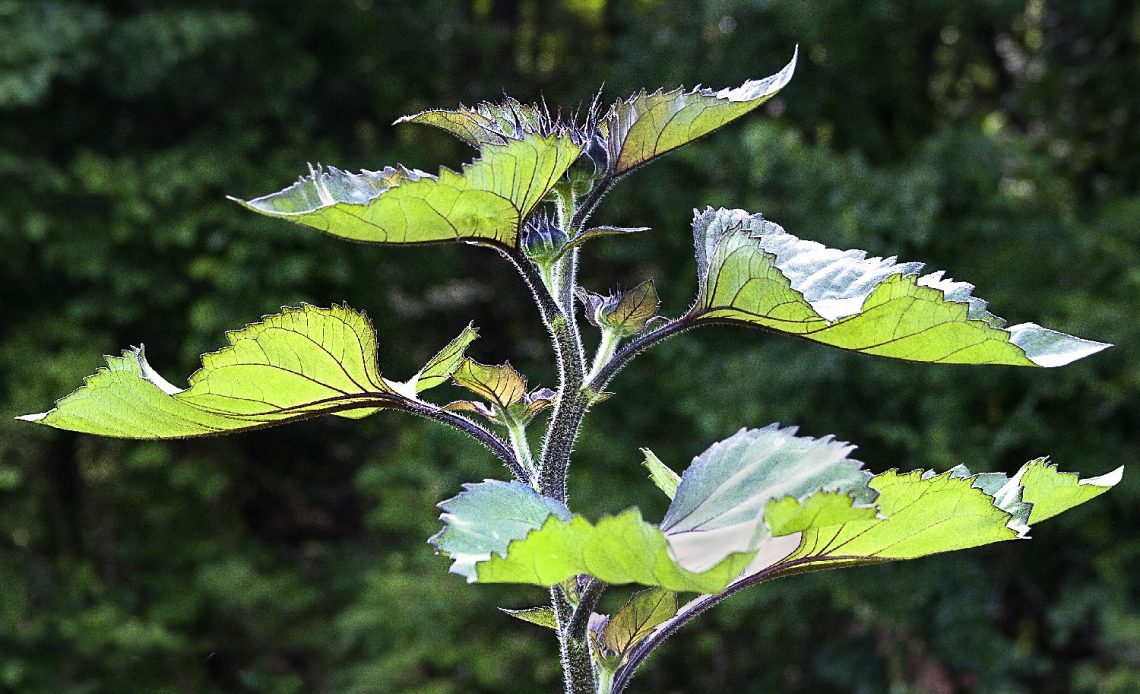

We’re here to help! Wild Yards is a completely free website that is 100% dedicated to helping you create a wildlife-friendly, sustainable yard. Read more
WildYards is reader-supported. When you buy a product through a link on our site, we may earn a comission. Every product is independently selected by our (obsessive) editors and our reviews are unbiased and objective. Read more about our mission or our privacy policy.
Sunflowers are such fun because they grow so quickly. These flowers provide fast shade for surrounding plants during the hottest days of the summer, and their high nectar content means they draw all kinds of valuable pollinators to your backyard, including hummingbirds, bees, and butterflies. But when you grow multiple plants from seeds together in your garden, you may not be able to tell what the sunflower leaves look like compared to other seedlings sprouting up nearby.
Young sunflower leaves are small and oval in shape with rounded or pointed ends and a soft, velvety texture. Mature sunflower leaves are triangular, heart, or oval-shaped and have a bristly fuzz on both the top and underside. Sunflower leaves alternate along the plant’s stalk, which is also prickly to the touch.
What do young sunflower leaves look like?
When sunflower seedlings first sprout, they don’t look exactly like the mature sunflower leaves you’d expect. This can make it difficult to know which of your new seedlings are sunflowers, which are vegetables, and which are weeds. Knowing what young sunflower leaves look like can help you determine which plants in your garden are growing where.
Sunflower seedlings produce bright yellow-green leaves. If you see them a few hours after they emerge from the ground, you may find the sunflower shell still stuck to the new leaves. Most sunflower varieties produce baby leaves that are plump, similar to succulent leaves. The leaves may also be covered in a delicate velvety coating.
Sunflowers are dicots, so their leaves grow in pairs with leaves alternating on opposite sides of the stalks. Seedlings will continue to grow their baby leaves until they reach about 6 inches tall when they begin producing true leaves.
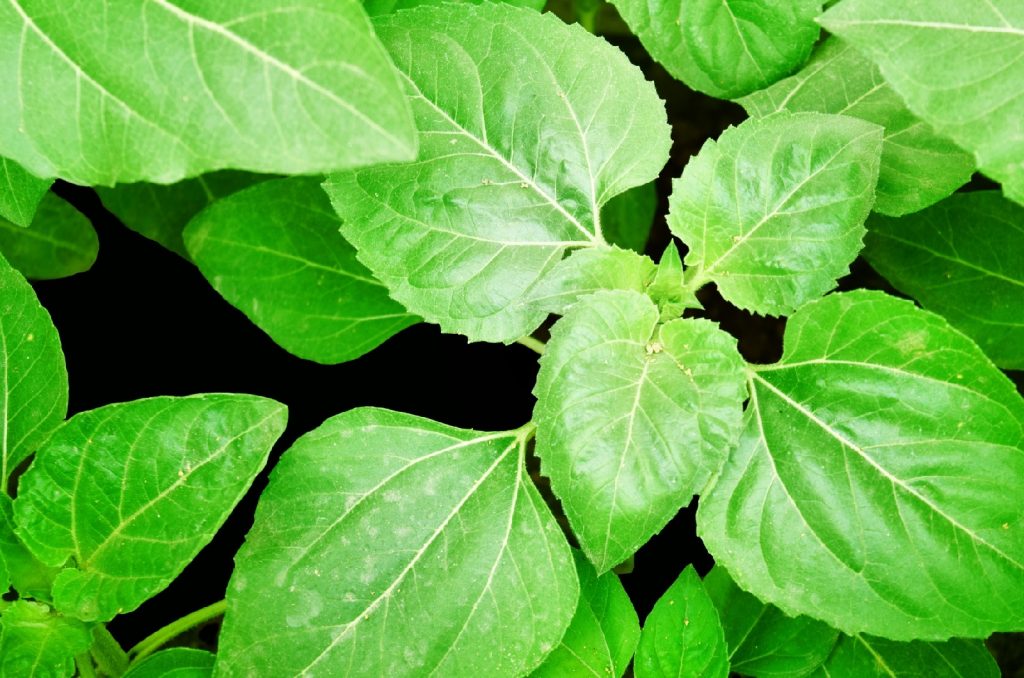
What do mature sunflower leaves look like?
A full-grown sunflower plant produces leaves that are triangular, heart, or ova-shaped. Each leaf has a thin vein bisecting it, creating a shallow dip in the center. The edges of the leaves are serrated, and the leaves themselves are covered in a stiff, prickly fuzz.
Sunflower leaves are not attached directly to the stalk. Rather, they grow from small stems that extend from the stalk that are pale gray or slightly purple. These stems are slightly fuzzier than the leaves, but not as fuzzy as the sunflower stalks, which are so prickly they can sometimes hurt to touch.
As the sunflower plant grows, its leaves grow, too. The bigger the sunflower, the larger its leaves. How big sunflower leaves grow ultimately depends upon the variety, but they average around 11 inches in length. The leaves of some sunflower varieties are also a deeper green than the traditional sunflower’s lime-ish green foliage.
Do other flowers look like sunflower leaves?
Once you’ve seen sunflower leaves, you’ll be able to identify them easier. But, unfortunately, several other popular garden plants also look like sunflower leaves. This can make differentiating between these plants difficult, but not impossible. It just takes a little practice.
Like sunflowers, zinnias are frequently grown in vegetable patches to attract pollinators, including butterflies and hummingbirds. Zinnia leaves are triangular with a rough texture and a vein that runs right down the middle, so they look a lot like sunflower leaves. But, unlike sunflower leaves, zinnias are not fuzzy, nor do they have serrated edges.
Daisies are also commonly grown to attract pollinators, especially butterflies and bees. These flowers are frequently mistaken for sunflower leaves, especially when they’re still seedlings. Baby daisy leaves are oval and bright yellow-green. They also grow in pairs on opposing sides of the flower’s stalks. But daisy seedling leaves tend to be longer than young sunflower leaves.
Do vegetable plants look like sunflower leaves?
Certain vegetable seedlings resemble young sunflowers, too — squash, gourd, and melon seedlings, in particular. These plants produce yellow-green leaves with veins bisecting them. The leaves are slightly fuzzy, as are the stalks. Because these plants are frequently grown as sunflower companion plants, they’re often mistaken for one another.
Tomatoes, too, can be confused for sunflower seedlings. Their leaves are triangular and fuzzy, but they tend to be a bit smaller than sunflower seedling leaves. Their fuzz is also less bristly, and more like the fuzz on lamb’s ear leaves.
How can you avoid confusing sunflower leaves with other plants?
Sunflowers are usually grown near vegetable patches to boost pollination rates and provide some shade to surrounding plants. While young sunflower leaves do look different from other seedlings, it takes a skilled eye to tell the difference.
If you’re new to gardening, be sure to label your rows carefully so you know which plants are where. And don’t uproot any plants until they’ve developed true leaves, which makes it easier to tell different plants apart.
Are sunflower leaves edible?
If you’re an avid backyard forager, you may be wondering if sunflower leaves are edible. The answer is yes. You can eat sunflower leaves. Healthy sunflower leaves that are free of disease and insect damage can be harvested from the plant, washed, and eaten fresh in salads, oven roasted, or sauteed.
It is worth mentioning that even though you can eat sunflower leaves, they’re not the most delicious foliage to gather. Dandelion leaves are a tastier alternative. However, sunflower sprouts can be gathered for a nutritious side dish. Sunflower sprouts are tender and juicy, much better for eating than tough, fuzzy mature sunflower leaves.
If you don’t want to uproot your sunflower seedlings to snack on, but you’re not sure you want to eat sunflower leaves, either, stick to harvesting the seeds. Roasted sunflower seeds are easy to make and are a healthful source of vitamins A and E, as well as many B vitamins.
What are your sunflower leaves trying to tell you?
If a closer inspection of your sunflower leaves reveals that they are discolored or covered in holes, they may be trying to tell you something. If your sunflower plants’ leaves don’t look like the healthy green foliage you’d expect them to, it’s time to evaluate them for nutritional deficiencies and diseases. Here are the most common problems gardeners see with their sunflower leaves.
Crunchy brown leaves
Sunflowers are hardy plants. Most varieties thrive in poor soils, and they’re very heat and drought-tolerant. But, tough as sunflowers are, they can still suffer from dehydration. When leaves turn brown and crunchy, they’re not getting enough water.
Crumbling brown leaves are a sign that your sunflowers need more moisture. But, remember, sunflowers are annuals. It’s their nature to die back at the end of the growing season. If your sunflowers have already bloomed and gone to seed, watering the plants won’t help. It’s normal for the leaves to dry up and die.
Yellow leaves
Yellow sunflower leaves are easy enough to spot, but they’re a bit trickier to diagnose. If you find yellow leaves, the first thing you need to look at is drainage. Sunflower foliage usually turns yellow when the roots are waterlogged. Loamy soils that are full of moisture-retaining organic matter may be retaining too much water. Be sure to amend your soil with sand, coco peat, or another perforator to improve drainage.
If overwatering isn’t the issue, your sunflowers are likely suffering from nitrogen deficiency. You can help correct this issue by using blood meal to fertilize your plants. You can also make a homemade nitrogen-boosting fertilizer by mixing 2 cups of used coffee grounds in a 5-gallon bucket of water. Let it sit overnight, then strain the coffee grounds. Water the plants with this mixture, or spray it directly on the sunflower leaves to help improve their color.
Holes in leaves
If you notice holes in your sunflower leaves, or if it looks like tiny bites have been taken out of them along the edges, you’ve got an insect problem on your hands. Aphids, greenflies, slugs, snails, and leafcutter bees are the most common sunflower pests.
Take a close look at your sunflower leaves. If there are only a few bugs, you can pick them off by hand. But if there are too many to remove manually, mix up a homemade pesticide with a clove of garlic, 2 tablespoons of vinegar, 5 drops of peppermint essential oil, and a gallon of water. This will help repel them. You can also purchase ladybug larvae to keep the pest levels down.
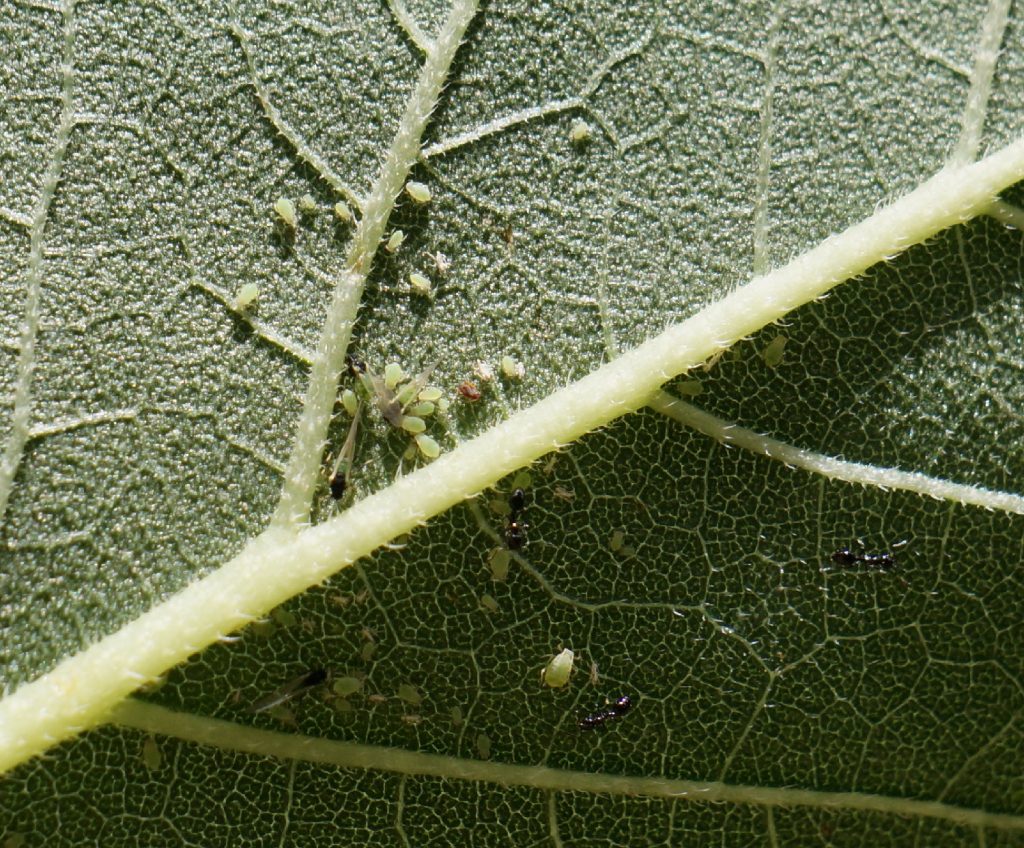
Curling leaves
Verticillium is a genus of fungi that leads to wilt and curling leaves. Sunflowers with curling leaves are most likely the victim of a Verticillium infection. In addition to curling leaves, they may display yellow or green discolorations on affected foliage.
Spraying your sunflower leaves with a homemade fungicide can help contain the infection. Removing affected leaves and discarding them, being careful not to toss them onto the compost heap where they can spread infection, may also help your sunflower plants.
Missing leaves
Leaves that are missing, stem and all, have probably been eaten by hungry foragers. Leaves that are missing from the bottom of the plant have fallen prey to hungry rabbits. When leaves are missing from the middle and top parts of the plant, deer are the most likely culprits.
If only parts of the leaves are missing, insects are probably responsible. Check your sunflower leaves for signs of caterpillars, beetles, and grasshoppers. Squirrels and chipmunks may also choose to browse on sunflower leaves, and because they’re much smaller than deer, they may not finish whole leaves, leaving small pieces behind.
Black spots
Small round black spots on sunflower leaves are the result of Alternaria also called black spot. This fungal infection can spread from the stems to the leaves to the flower heads, infecting the whole plant. If it progresses, it may kill the plant and infect surrounding sunflowers, too.
To make matters worse, many vegetables are also susceptible to black spot as well. Members of the Brassica family, including cabbage, cauliflower, broccoli, kale, and Brussels sprouts are especially vulnerable to black spot. If your sunflowers are infected and are close to your vegetables, be sure to treat them with a homemade fungicide to prevent the spread of this disease.
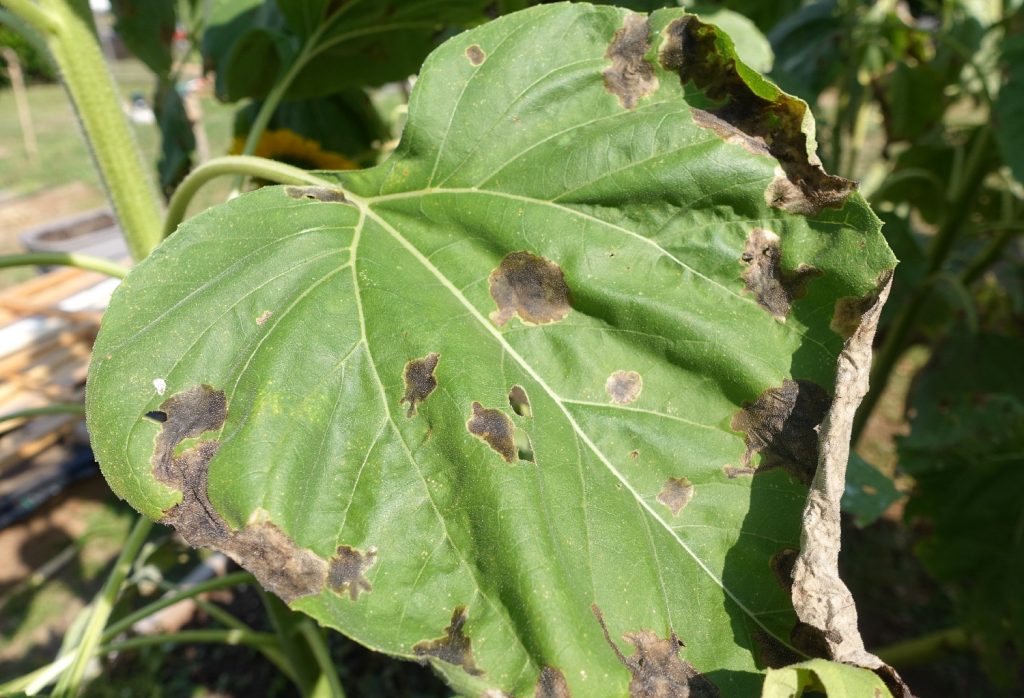
Discolored leaves
Yellow, white, and brown spots and other discolorations are often caused by insect infestations. Insects like cutworms and beetles can bore holes into sunflower leaves, which can cause significant damage to the foliage. These holes also make the leaves more susceptible to diseases.
Are you noticing tiny brown spots on the undersides of your sunflower leaves? That’s sunflower rust caused by Puccinia Helianthi, a fungal pathogen that can develop into black pustules if left untreated. Sunflower rust kills leaves quickly, and spreads from sunflower to sunflower in a matter of days, threatening the health of the whole crop. Be sure to spray infected plants with a homemade fungicide to contain the infection.
How can you help your sunflowers produce the healthiest leaves possible?
Healthy foliage is a sign of a healthy plant. If you want your sunflowers to produce the most vibrant blooms possible, it starts by supporting leaf quality. The best way to do this is to ensure your sunflower’s growing requirements are being met. Plant your sunflower seedlings in well-draining soil that is neutral to slightly acidic, in a place where they receive at least 6 hours of sunlight every day. This will give them the best chance of success.
Sunflowers should be watered regularly, but not overwatered. Give your sunflowers a chance to dry out completely between waterings. If it’s especially hot and your region is going through a dry spell, you’ll need to water more often, especially if your notice your sunflower leaves starting to wilt.
Sunflowers do not require fertilizers to grow, but providing them with the nutrients they need most can improve performance and reduce their chances of developing diseases. Choose a fertilizer that contains nitrogen, potash, and potassium. This will provide them with the nutritional building blocks they need to stay as healthy as possible.
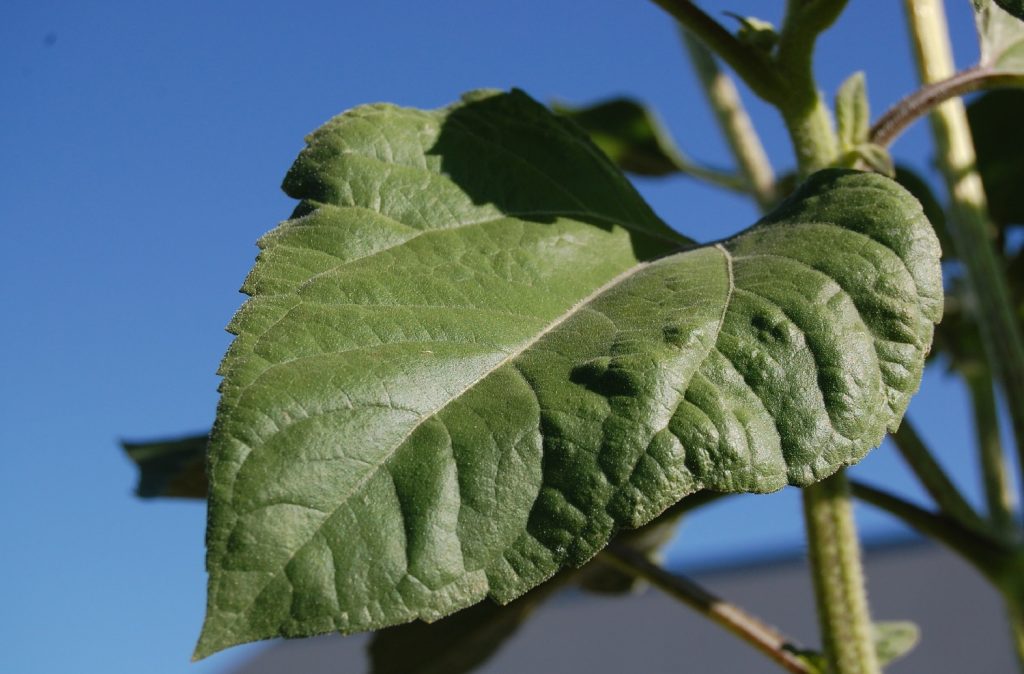
Keeping sunflower leaves healthy: final thoughts
Whether you grow your sunflowers to collect the seeds, leaves, and flower heads or whether you grow them to protect your vegetables and bring more wildlife to your backyard, keeping their leaves healthy is critical to your plant’s wellbeing.
By giving your sunflowers everything they need to thrive, and by supporting their nutritional needs with the help of a good fertilizer, you can support healthy sunflower leaves and enjoy these bright, cheery blooms all season long.
